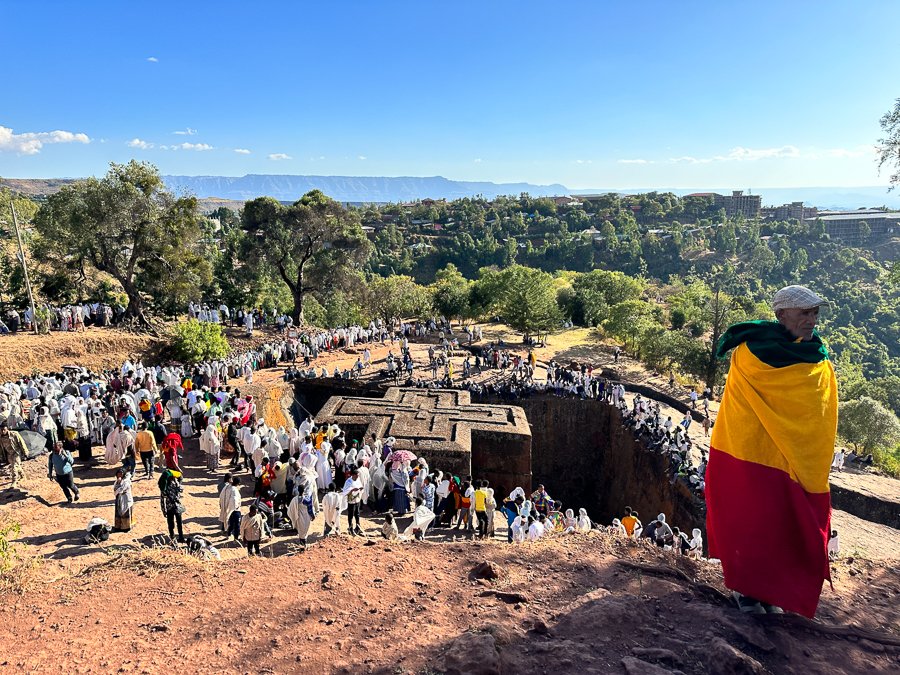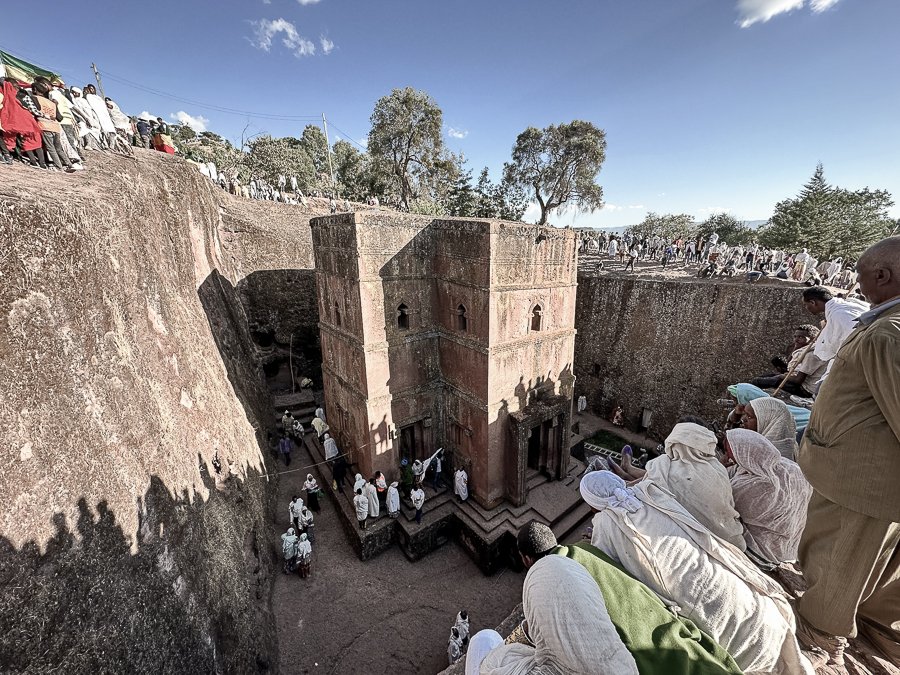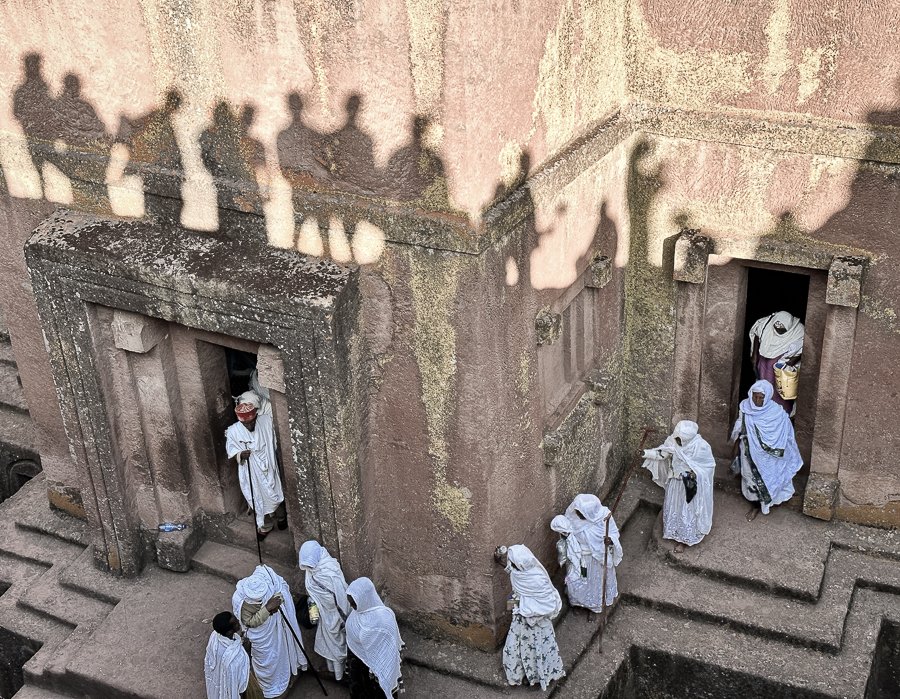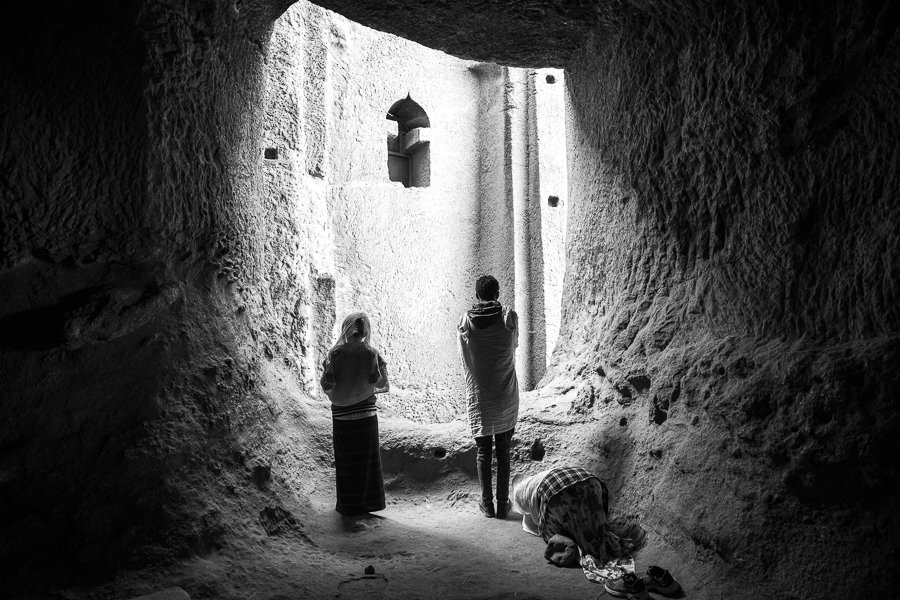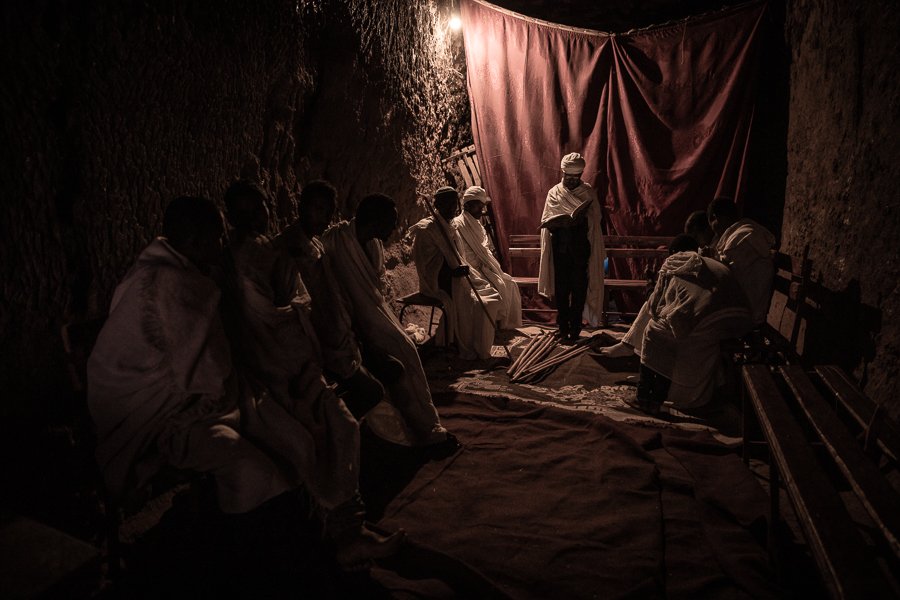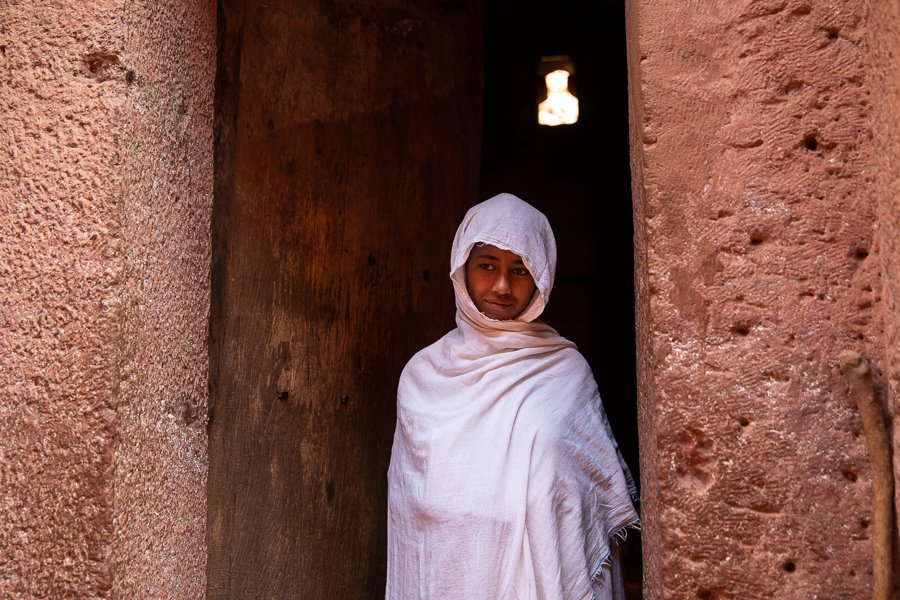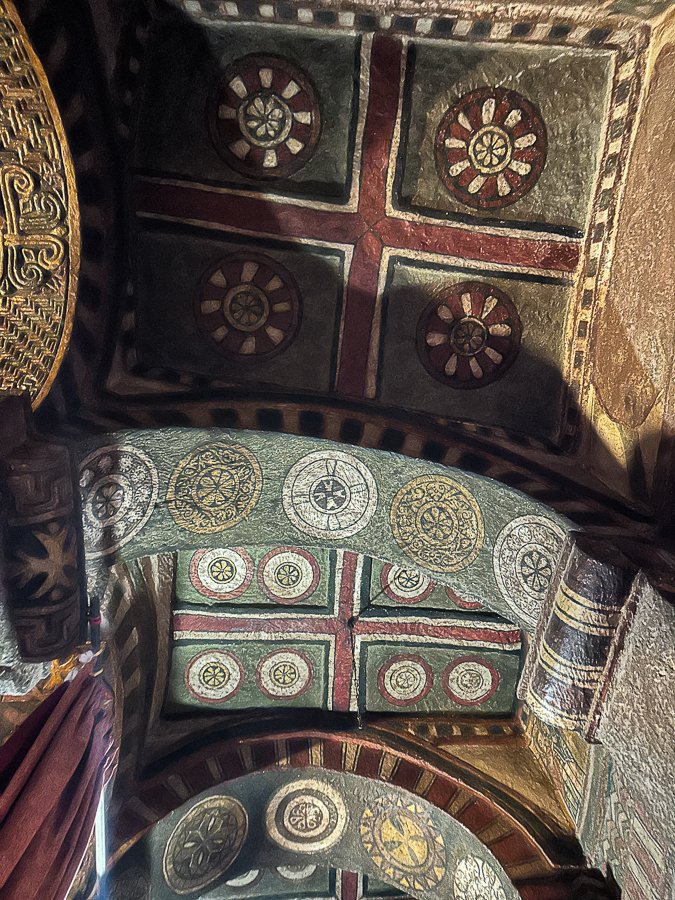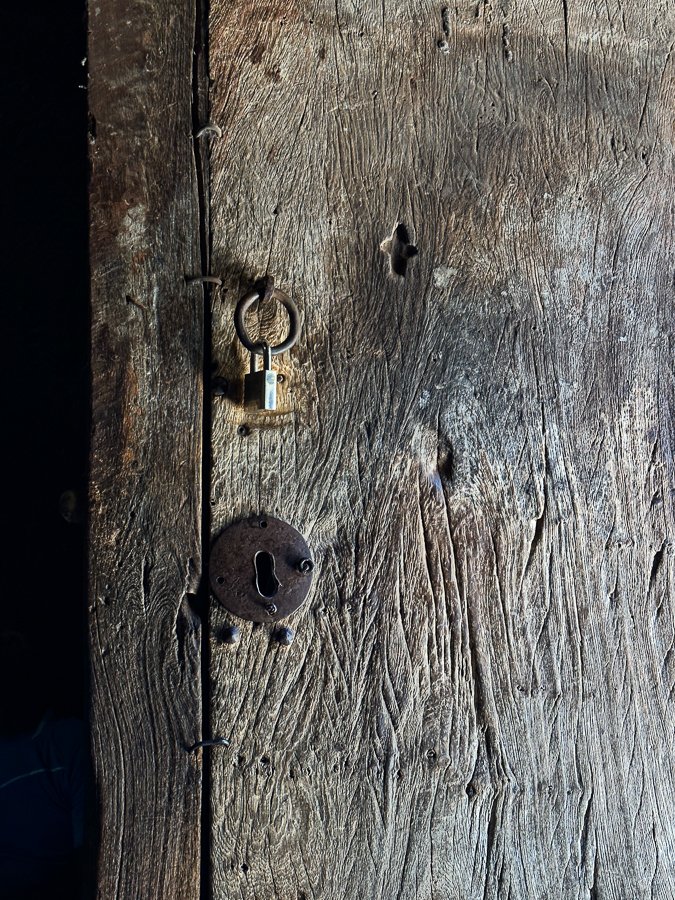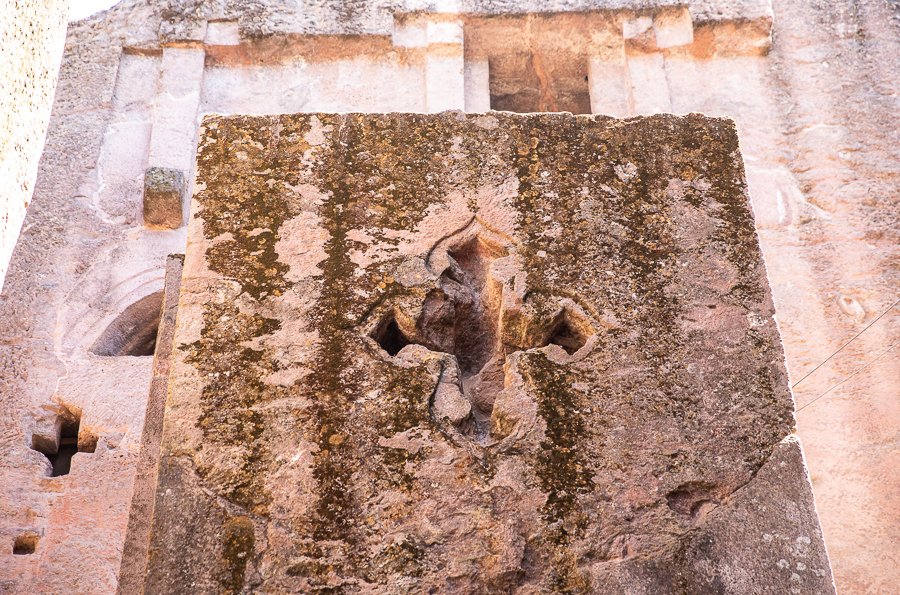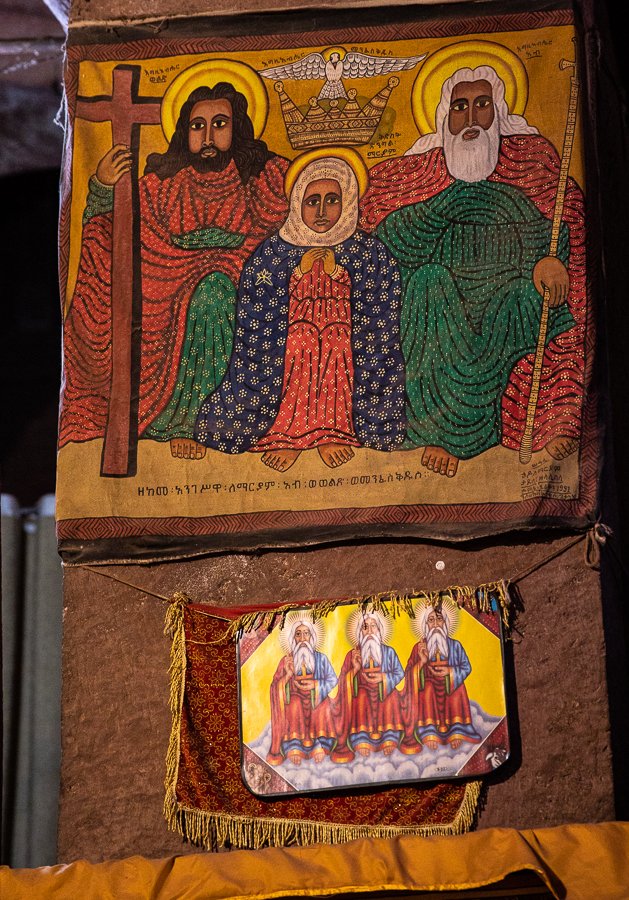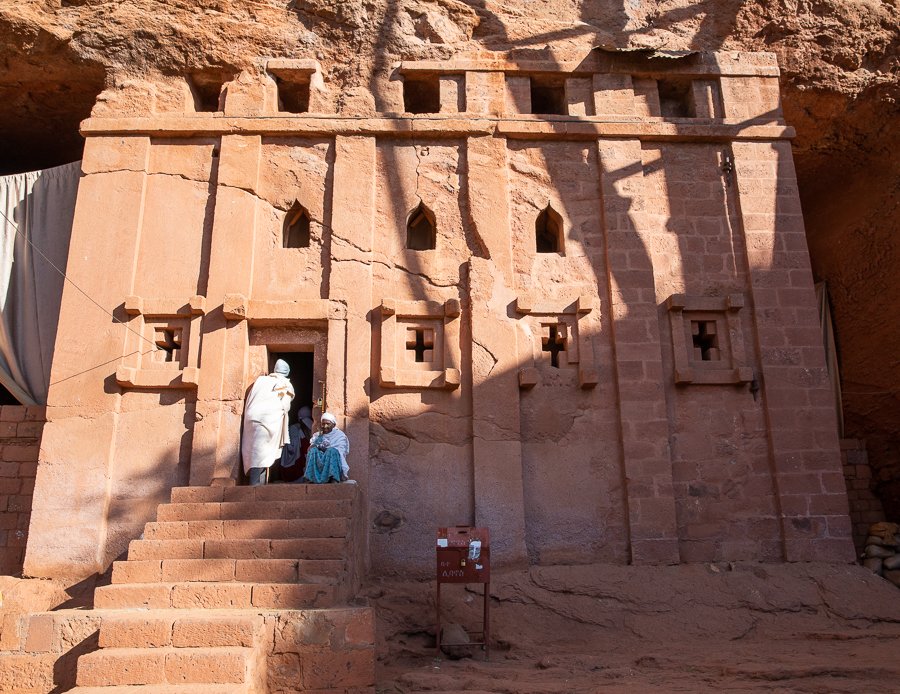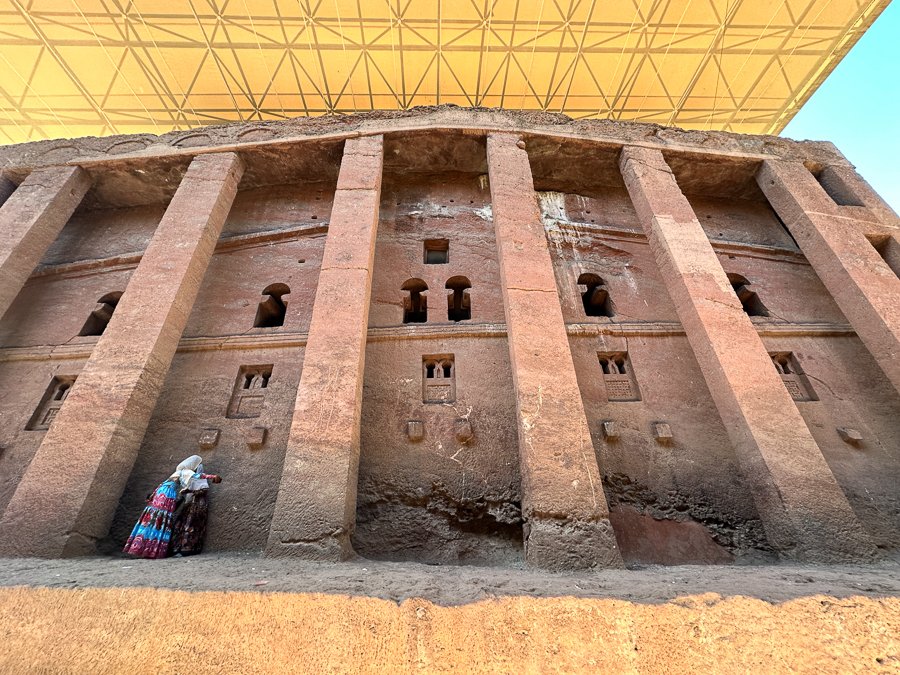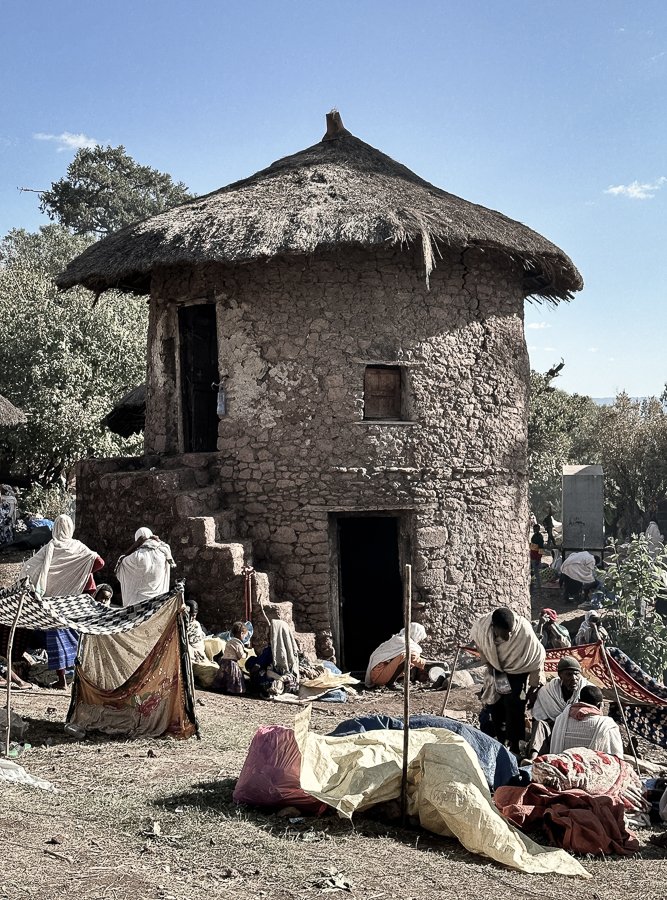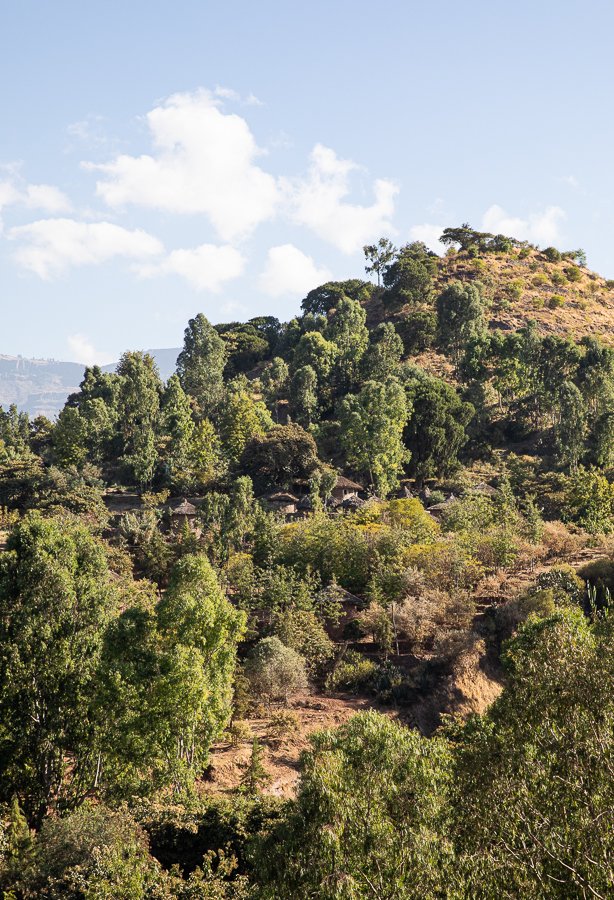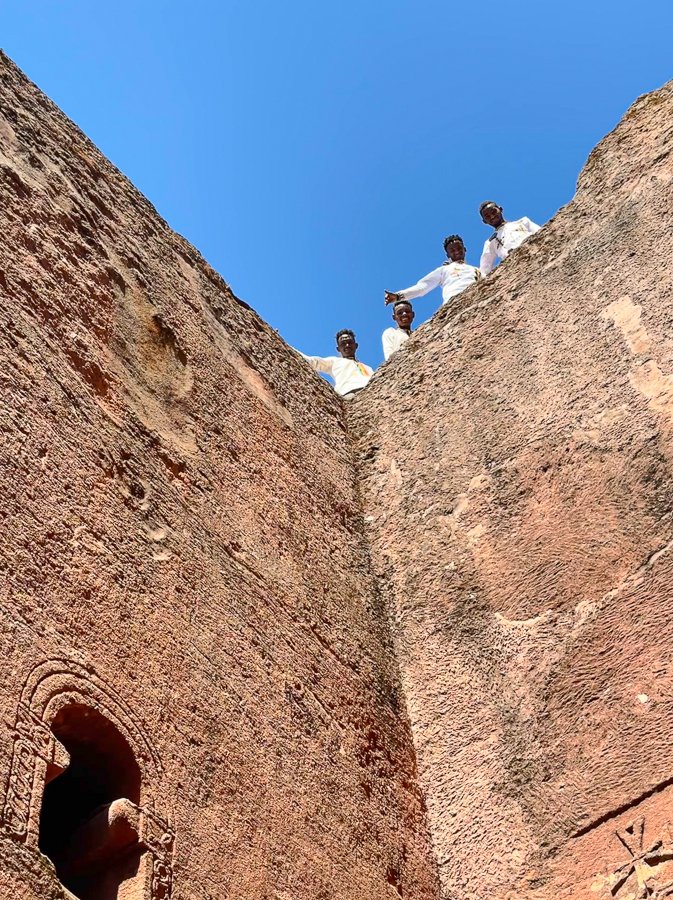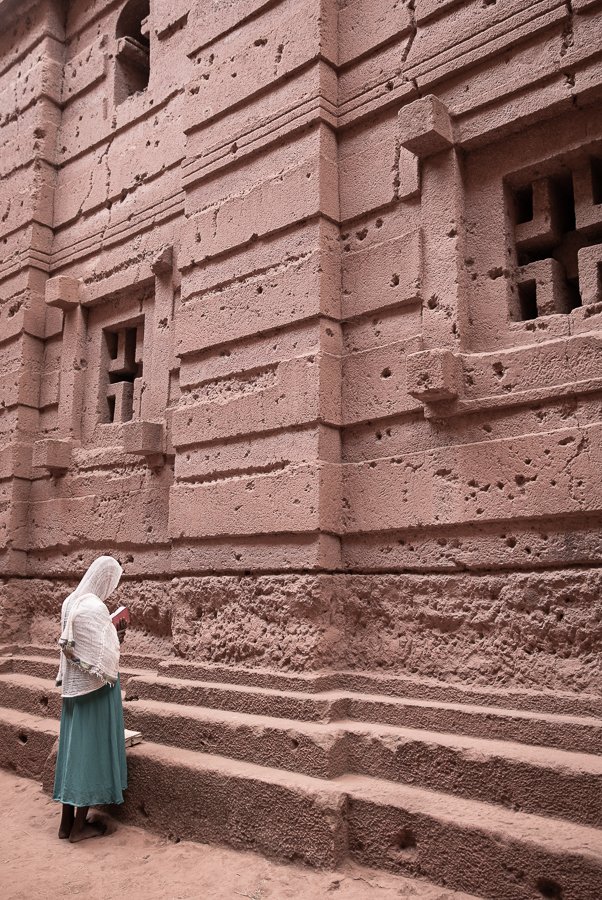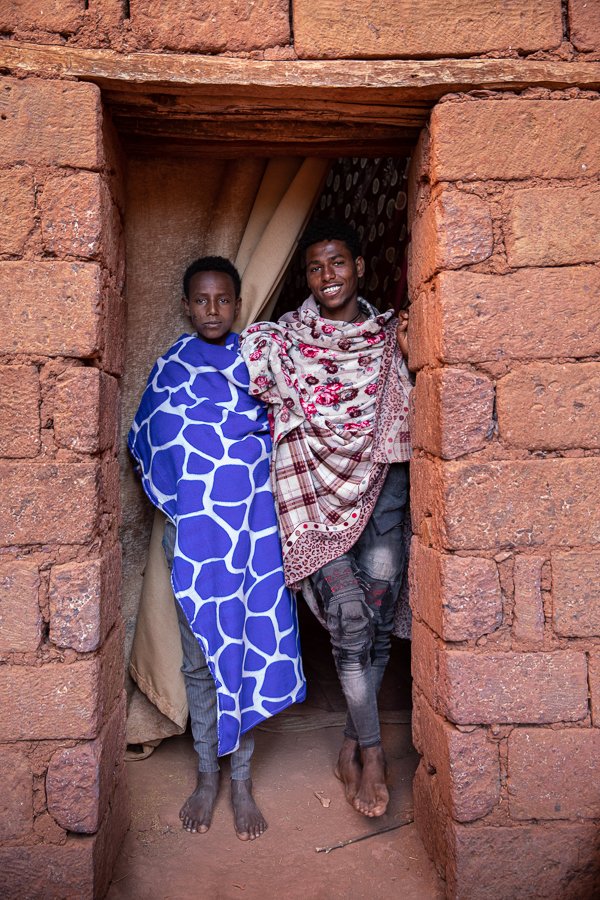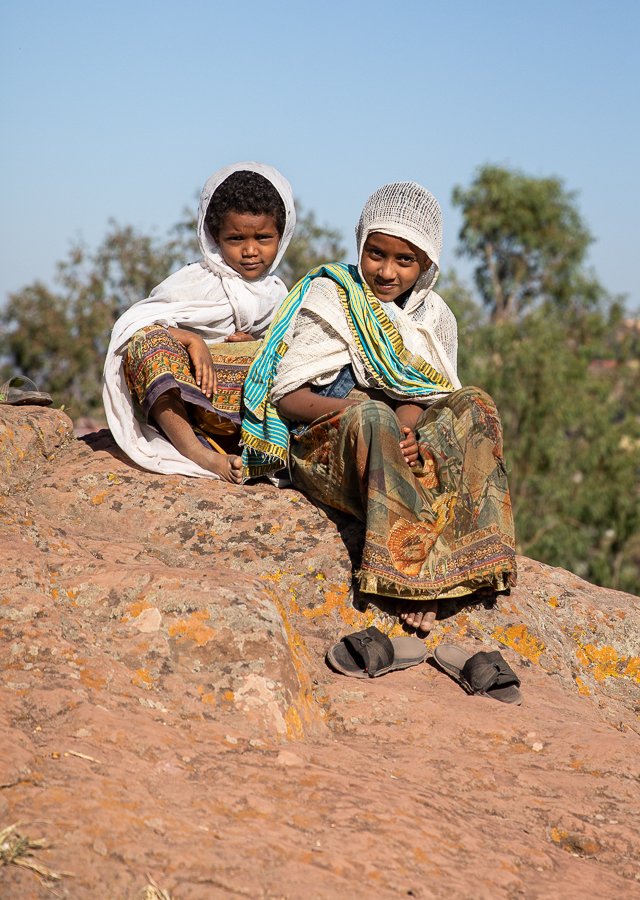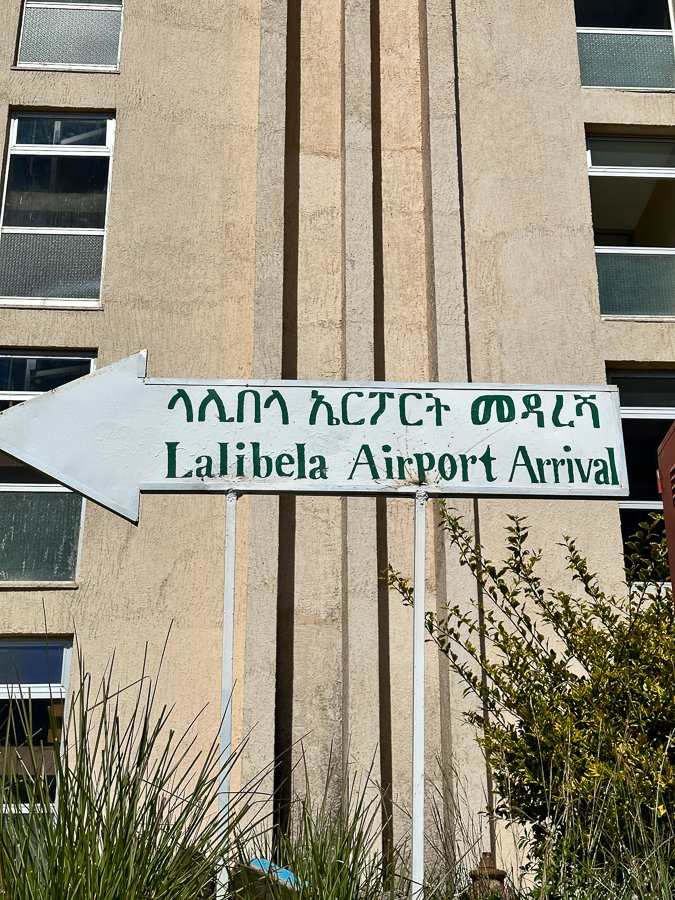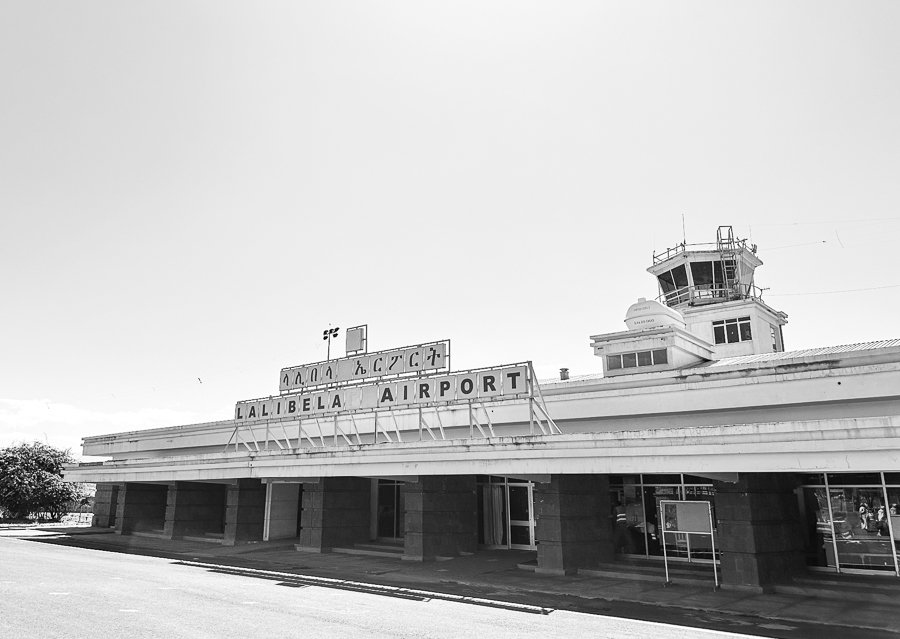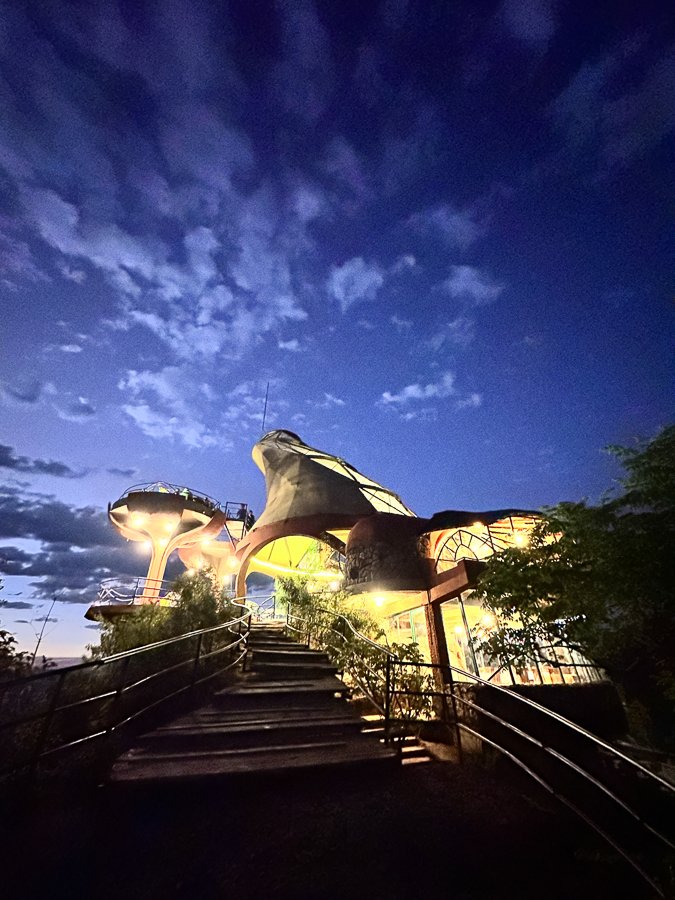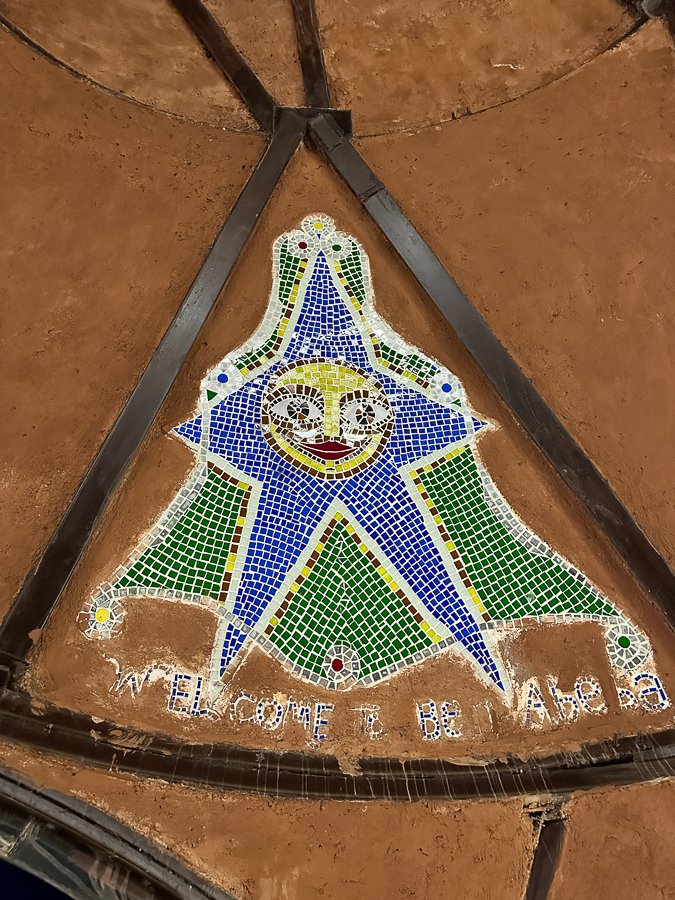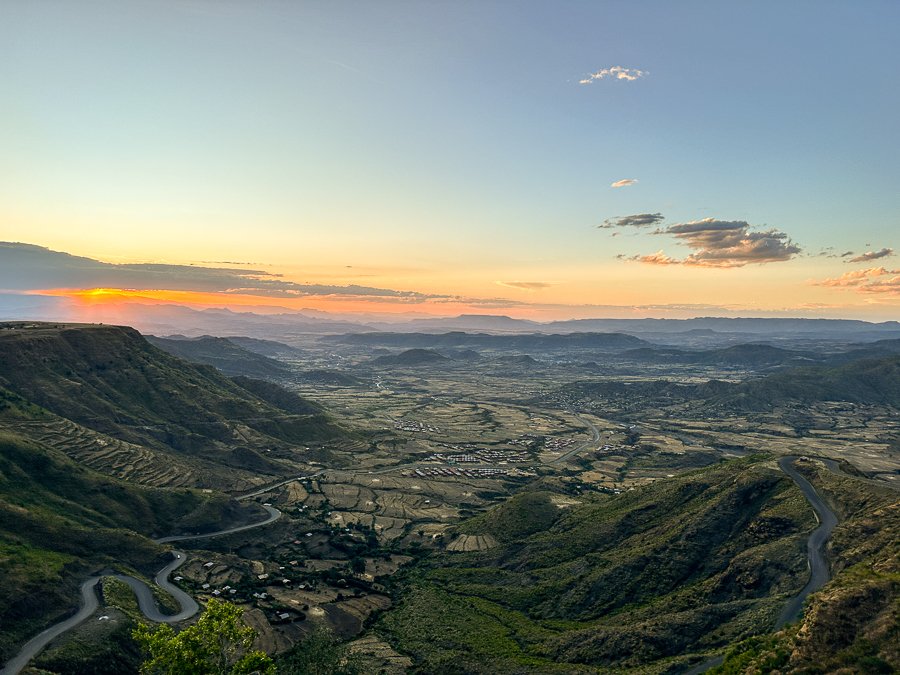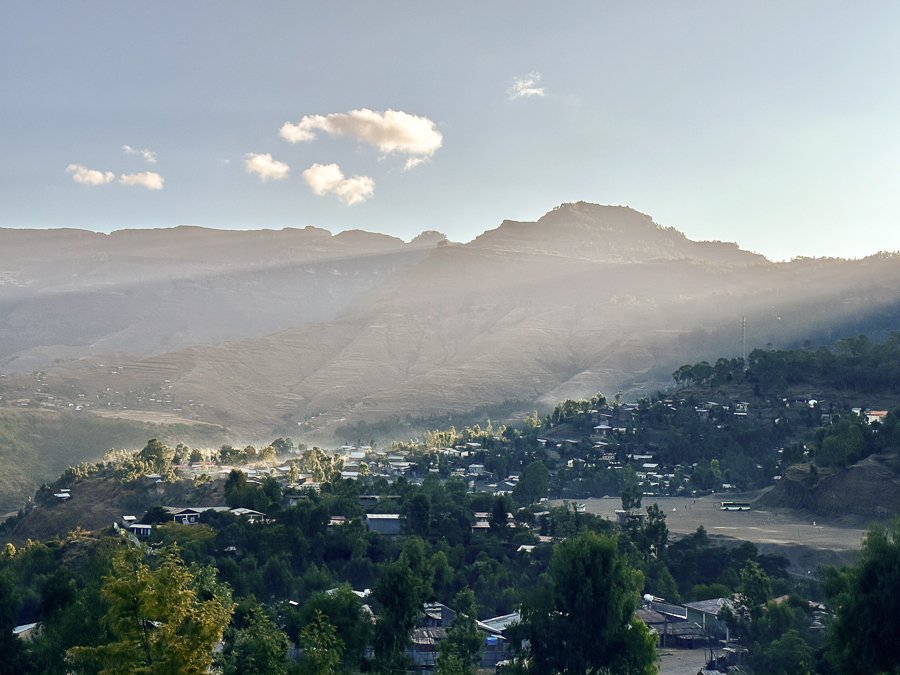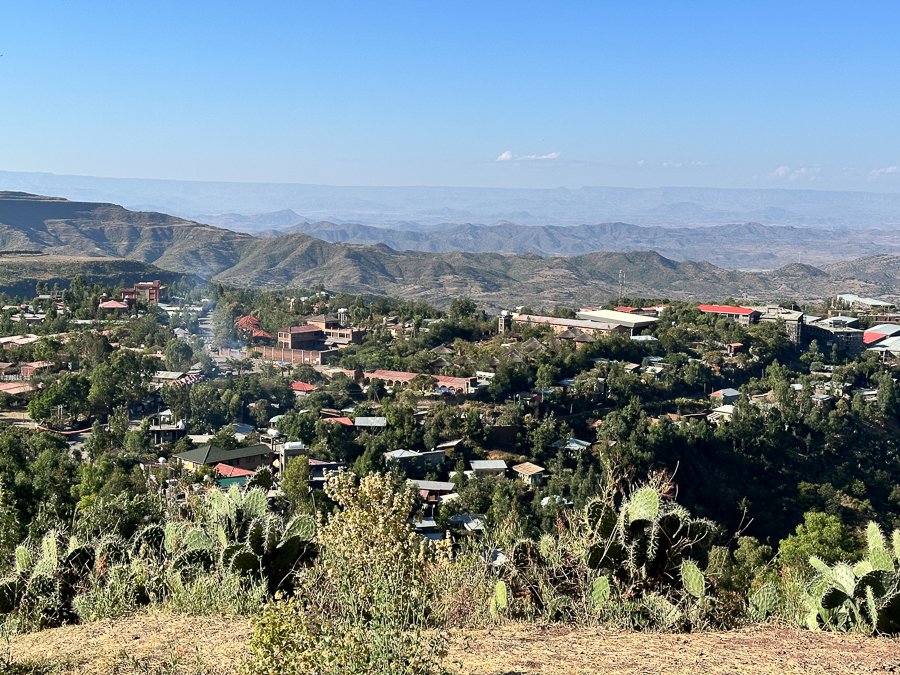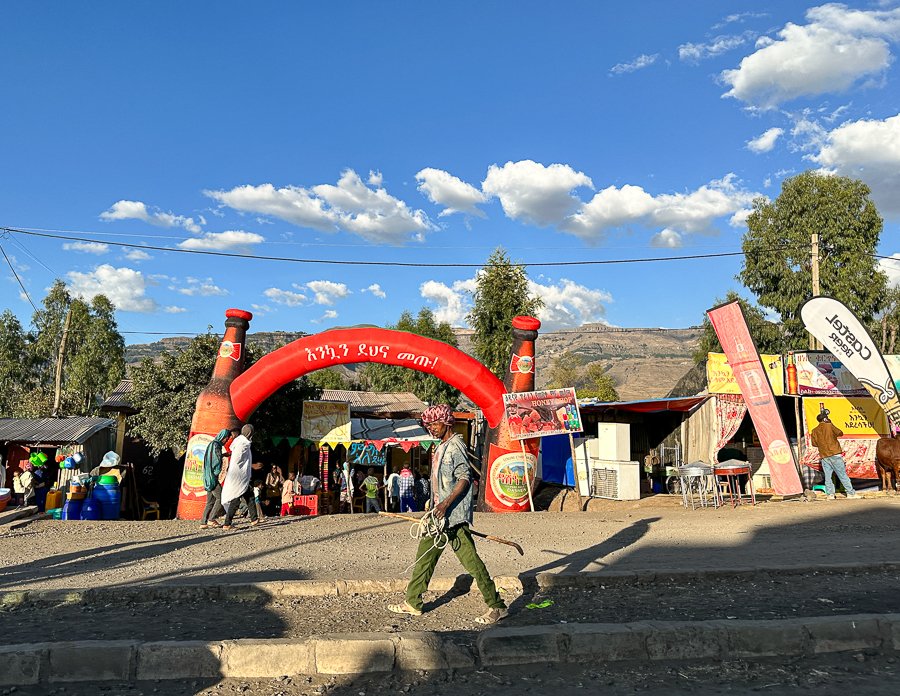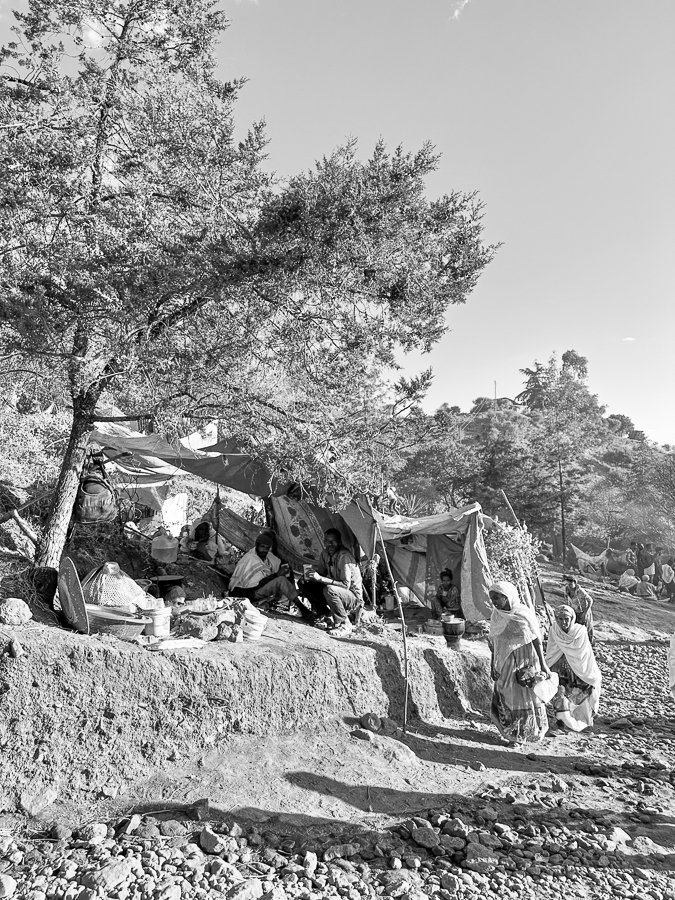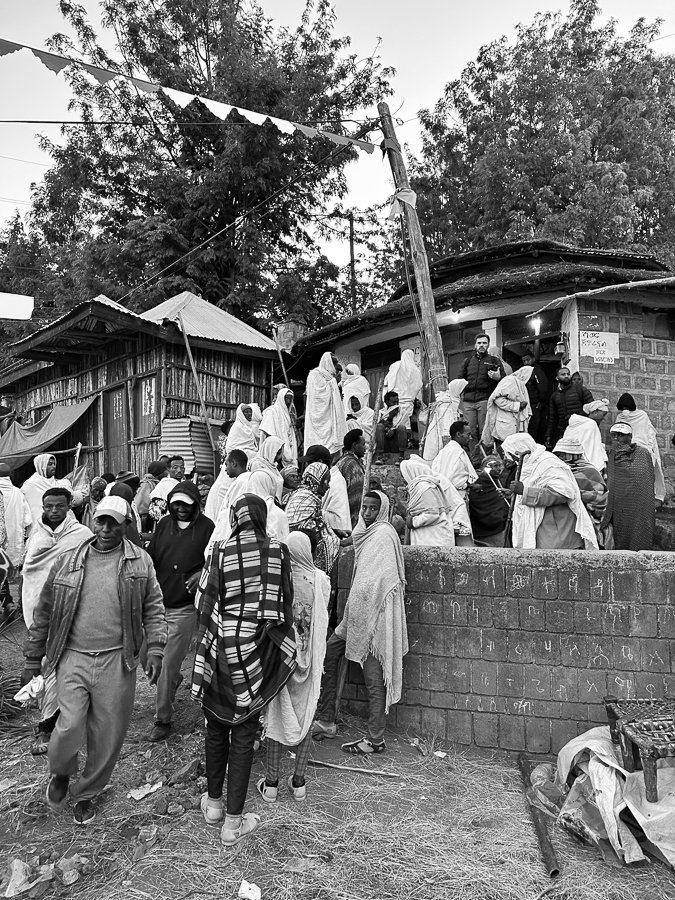lalibela is a “must see” location in northern ethiopia
I have unforgettable memories of being surrounded by hundreds of thousands of devoted pilgrims and making my way through tiny underground passageways to visit the rock-hewn cave Lalibela churches. A famous town due to its religious, historical and architectural wonders, Lalibela in Northern Ethiopia is definitely worth visiting.
An intensely spiritual and historic town in the north of Ethiopia, Lalibela is home to eleven medieval monolithic cave churches carved out of rock and is one of the incredible UNESCO World Heritage Sites in Ethiopia. It is historically a place of significant importance and a place of devotion for Ethiopian Orthodox Christians and remains the most important place of pilgrimage in modern day Ethiopia.
the church of st george is the most famous of the lalibela cave churches
The most iconic and well known image from Lalibela is the famous rock-hewn church in the shape of a cross, The Church of Saint George. With the roof of this rock-hewn monolithic church the same height as the ground surrounding it combined with its unique cross shape it has become not only a “must see” sight in Ethiopia, but in Africa.
A world of tunnels and ceremonial passageways
Walking through the “tunnel of hell” otherwise known as the “pathway to hell” is a long windy tunnel of complete darkness. With our guide leading the way and saying “follow me” it sounds simpler than it was. You have no idea where you are walking, how narrow the tunnel gets or how low. These tunnels and pathways that connect the churches are carved from rock, so they are not completely flat.
The entrance of the “pathway to hell”
A tunnel of complete darkness…
In the darkness of the pathway to hell I had one hand feeling the tunnel wall on my upper left…trying to feel in which direction I should be walking and also the height so I didn’t hit my head. The other hand had one finger on the backpack of my client on his private tour who was between myself and our guide. We shared a few giggles of bewilderment on the tunnel of darkness as we had no idea where we were walking. With children behind me in the tunnel walking and occasionally stepping on my skirt I had no hands left to pick up, I was fortunate my skirt was still intact when we saw the light at the end of the tunnel and exited this unbelievable tunnel.
With our guide leading the way my client, Andrew enters the “pathway to hell”…we had no idea what to expect.
This experience still puts a smile on my face just thinking about it!
It is believed that prisoners walked this tunnel as there is evidence in the outside church area near it of where chains could have been attached many hundreds of years ago. It certainly was an incredible experience and fortunately most of the other tunnels we went in where much shorter or you weren’t in complete darkness for so long.
King lalibela wanted to create a “new jeruselum”
Lalibela was named after King Gebre Mesqel Lalibela who was the person that commissioned the eleven churches. His vision was to recreate the holy city Jerusalem in his own kingdom. It is mostly believed that it took 24 years to build all 11 rock-hewn churches with King Lalibela’s vision between the late 12th century and early 13th century. Many worshippers believe that angels built these unique religious structures (or that the building process was helped by angels).
Although it is widely believed that the churches were built during the 12th and 13th centuries, the oldest of the Lalibela churches, Bete Miriam has been dated back to the 7th century which was during the Kingdom of Axum.
LALIBELAS CHURCHES ARE A UNESCO WORLD HERITAGE SITE
UNESCO World Heritage Site
Lalibela is Ethiopia’s most well known UNESCO world heritage site. It is spelt differently on this UNESCO sign, but Lalibela is the correct spelling.
Ethiopia has eight UNESCO cultural world heritage sites and one UNESCO natural world heritage site.
The unique structures all vary in size, shape, design and symbolic importance. An incredible UNESCO World Heritage Site these Lalibela churches were built with their own drainage, ceremonial passages, trenches, tunnels, hermit caves and religious significance. Several of them have decorative paintings and large murals inside. Millions of people over hundreds of years have entered these churches and walked these tunnels and overtime some of the volcanic rock has become slippery smooth…like polished rock.
what makes lalibelas rock-hewn churches so special?
These famous Orthodox Christian Churches in Lalibela are carved out of hills made out of porous reddish volcanic rock. They are all carved uniquely from their surroundings. Some are freestanding, having no walls or roof still intact with the surrounding rock. While some are carved with the roof or walls still intact with the surrounding rock. Every window, door, carving and pillar has either a structural or symbolic purpose. The detailed information from your local guide when visiting Lalibela’s churches is a treat in history and architecture.
You can see from the two churches above, that the left one is built into the top of the hill so the roof and the hill are still intact. However, the one on the right is like the Church of St George and is freestanding from the surrounding rock/hillside.
PRESERVING THE CHURCHES IN LALIBELA
Some of the churches have been protected by outside elements with temporary large structures that look like large shade sails (like one of the photos above). Offering some protection in maintaining these iconic and incredible architectural wonders, it is believed that more permanent structures that look more appealing will replace these ones in the future years. Fortunately for visitors the most famous Saint George Church in Lalibela doesn’t have an external covering.
Access to the Church of St George is through carved out trenches and tunnels.
LIST OF NAMES OF THE 11 LALIBELA CHURCHES
Church of St George / Bete Ghiorgis
Church of the Saviour of the World / Bete Medhani Alem
Church of Mary / Bete Mariam
Church of the Cross / Bete Maskal
Church of Virgins / Biete Denagel
Church of Golgotha Mikael / Bete Golgotha Mikael
Church of Emmanuel / Bete Amanue
Church of St Mercoreus / Bete Qeddus Mercoreus
Church of Abbot Libanos / Bete Abba Libanos
Church of Gabriel Raphael / Bete Gabiel Raphael
Church of Holy Bread / Bete Lehem
In Amharic “Bete” means “House”, but I have changed House to Church as that is what they are more commonly called rather than the direct translation. The Church of St George is not in a group with other churches, but it is still connected via carved out trenches/paths and tunnels. There is also a church called Genete Mariam, but it is about 25km South East of Lalibela and due to its remote and isolated location is less visited.
THE TRADITIONAL HOUSES OF LALIBELA
The traditional houses of Lalibela are two story round houses with thatched roofs and an internal staircase. While you can still see these original structures in Lalibela, the town is growing and expanding with more modern rectangular homes being built outside the town.
PHOTOGRAPHY IN LALIBELA AND ITS RELIGIOUS SITES
I had been to Ethiopia several times before I visited Lalibela. I am not someone that usually likes to photograph people in religious settings or in prayer. I believe that this is a special time and respect needs to be shown. However, my first trip to Lalibela was for Ethiopian Christmas Day and so being in such a religious setting for a religious holiday and celebration was different and something I was excited about. People were not only happy to have their photos taken, but many wanted photos with me and also my client…people have come from all over Ethiopia to celebrate the birth of Jesus and everyone was taking photos to remember!
Now that I’ve been to Lalibela I think it would be a great place to visit any time of year. People are very welcoming…the locals, the monks, priests and pilgrims. They are so proud of Lalibela and it’s rock-hewn churches and their religion.
HOW TO VISIT LALIBELA, ETHIOPIA?
The easiest way to get to Lalibela is a short (aprox 1 hour) flight with Ethiopian Airlines from Addis Ababa. Ethiopian Airlines offers a substantial discount on its domestic flights if you are an Ethiopian national or have an international Ethiopian Airlines ticket.
You can drive to Lalibela which usually takes two days, but keep in mind due to the terrain it is very windy and a long drive. I highly recommend flying there! You don’t fly direct into the town due to the mountainous area, but it is only a short windy drive (hotel shuttle) over a mountain to the town centre.
how far is Lalibela from Addis Ababa, ethiopia?
Lalibela is in Northern Ethiopia in the Amhara Region and 645km from Ethiopias capital, Addis Ababa. This holy town is surrounded by spectacular mountains and is 2,600m above sea level. The residents include a large community of monks, priests and worshippers. During the many religious holidays throughout the year the town becomes overflowing with hundreds of thousands of pilgrims. The busiest two days of the year being January 6th and 7th when Orthodox Christians from all over Ethiopia flock to the rock-hewn churches of Lalibela to celebrate Ethiopian Christmas.
what to wear as a tourist when visiting lalibela
Shoes that can be taken on and off easily are the best option when visiting Lalibela’s churches. Keep in mind that they may get mixed up or go missing when you are in the church (unlikely, but it is possible) so wear your most expensive sandals at your own risk. Also keep in mind that your shoes need to be comfortable to walk in. Most of the ground is uneven, there are steps/stairs and bridges to cross as well as the areas from hotels and around the churches being up or downhill. You can walk slowly and take breaks, so you don’t need to be super fit, but you do need to know there is a bit of walking involved. If you are not there on a religious holiday you can get a tuk tuk back to your hotel, but keep in mind during religious holidays most vehicles including tuk tuks can’t go through the main town as it is just too busy with people.
Mule, myself and our client, Andrew on his first part of his private tour with us!
For females a long skirt is needed when visiting the churches. If you don’t have a white shawl you can buy one in Lalibela at many places. It shows respect covering your hair as that is what the Orthodox Christian females do. It is not a requirement for tourists, but I certainly feel more respectful wearing a white shawl. For males I’d recommend long pants - perhaps travel trousers so you remain cool on the warmer days. Due to its altitude Lalibela can get cooler once the sun goes down, so a good jumper or jacket is useful.
famous Lalibela restaurant Ben Abeba
When visiting Lalibela there is one restaurant that must be visited. An incredibly unique architectural creation the Ben Abeba Restaurant was a vision by its owners Susan and Habtamu. Many people have heard of the Scottish lady in Lalibela, and when I met Susan upon arriving at Ben Abeba it was an absolute delight. Ben Abeba Restaurant was opened in 2012 and I had seen it featured in a documentary due to its distinctive eccentric style and amazing reputation. It temporarily closed in 2020 due to the pandemic and then was delayed in reopening due to the civil war. At the end of 2021 The Ethiopian military regained control from the TPLF and Lalibela slowly has began rebuilding and reopening. On Ben Abeba’s website it says it opened again in Dec 2022 however we visited on Christmas Eve, January 6th, 2023 and it was the first evening they had been open. They were understaffed and the waiters were working hard, but their customer service was still exceptional and all their customers appreciated it was their first night opening and were just grateful it had been able to reopen after the damage it encountered during the TPLF occupation of Lalibela.
Ben Abeba Restaurant has traditional Ethiopian food as well as food catered more for westerners. There are a variety of dining areas. After sunset we could no longer see the spectacular landscape below, so we moved to a bonfire area out of the wind where we ate our dinner. It was a great end to my clients first day in Ethiopias amazing holy city, Lalibela.
The scenery around Lalibela
Surrounded by mountains and being 2600m above sea level, there are some beautiful views around Lalibela. There are hotels with beautiful views a bit further out of town (but still a short walk), or in the older part of town there are also hotels but with no views. If you are a photographer make sure when you book that you book somewhere with a view. It’s spectacular at sunset.
is Lalibela safe?
I’m constantly asked if it is safe to travel to Ethiopia. There are often isolated issues in Ethiopia mostly because of politics, religion or ethnic/tribal backgrounds. We hear the bad parts in the news, but often these are not accurate. Lalibela is usually a very safe place to visit. Usual common sense and being street smart is important as there are many poor people who will take an opportunity if it arises. However, petty theft is not uncommon in most parts of the world. I have never felt I am personally in any danger or at harm on any of my trips in Ethiopia. Having the right Ethiopian ground team and travelling with the right people is also important here too. If there is an isolated area that my be best to be avoided when you are travelling in Ethiopia just make sure your plans are flexible and change where you are visiting. Ethiopia is a big country and due to the terrain it is not easily accessible to get to one place to another. If there are problems in one town it is unlikely the problems will be felt a couple of towns away. Its peace of mind when travelling to a country like Ethiopia that there are always safe places to visit…despite what the media may portray.
How many days do you need in lalibela?
If you are planning a trip or have already planned a trip to Ethiopia and have a few days spare, then definitely consider two nights in Lalibela. It is an easy add-on to an existing itinerary, with easily accessible flights from/to Addis Ababa. The churches are usually open to tourists between 8am - 12pm and then 2pm - 5pm.
Day 1 - fly Addis to Lalibela. shuttle from Lalibela airport to hotel for check-in. Then meet your local guide and walk and discover some of the rock-hewn churches of this unique UNESCO World Heritage Site in the afternoon.
Day 2 - morning walk visiting the churches followed by a break for lunch. Then in the afternoon completing the tour of these churches.
Day 3 - walk in Lalibela town before flight back to Addis Ababa.
I’d recommend booking the three days tour with who you’re booking the rest of your trip with. They would’ve organised the tour guide to meet you at your hotel upon arrival in Lalibela. Or you can contact my recommendation Your Driver in Ethiopia to book and organise everything for you.
Ready more about Ethiopian Christmas Celebrations in Lalibela on my next blog post CLICK HERE
To read my blog on the Konso village UNESCO World Heritage site in Ethiopia CLICK HERE
To read about the Ethiopian UNESCO World Heritage Site of Harar CLICK HERE


